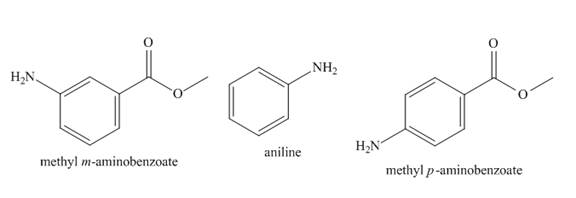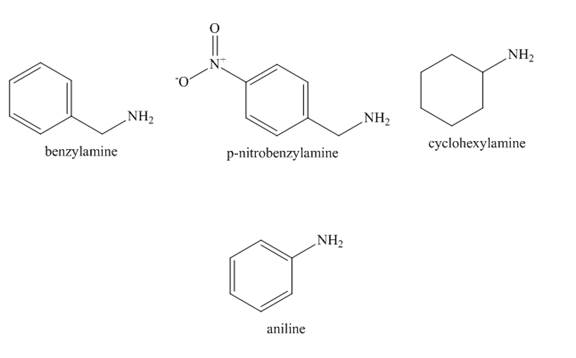
Concept explainers
(a)
Interpretation:
The increasing order of basicity of propylamine, ammonia, and dipropylamine in aqueous solution is to be arranged.
Concept introduction:
Answer to Problem 23.7P
The increasing order of basicity of propylamine, ammonia, and dipropylamine in aqueous solution is shown below.
Explanation of Solution
It is known that the order of basicity of amines in aqueous solution is
The increasing order of basicity of propylamine, ammonia, and dipropylamine in aqueous solution is shown below.
(b)
Interpretation:
The increasing order of basicity of
Concept introduction:
Amines are the organic compounds that are formed by replacement of hydrogen from ammonia. Amines are basic in nature because the nitrogen can donate its lone pairs and also the ability of the nitrogen to accept the proton in water.
Answer to Problem 23.7P
The increasing order of basicity of
Explanation of Solution
It is known that the order of basicity of amines in aqueous solution solution is
The increasing order of basicity of
(c)
Interpretation:
The increasing order of basicity of aniline, methyl m-aminobenzoate, and methyl p-aminobenzoate in aqueous solution is to be arranged.
Concept introduction:
Amines are the organic compounds that are formed by replacement of hydrogen from ammonia. Amines are basic in nature because the nitrogen can donate its lone pairs and also the ability of the nitrogen to accept the proton in water.
Answer to Problem 23.7P
The increasing order of basicity of aniline, methyl m-aminobenzoate, and methyl p-aminobenzoate in aqueous solution is shown below.
Explanation of Solution
The structure of aniline, methyl m-aminobenzoate, and methyl p-aminobenzoate is shown below.

Figure 1
Amines are basic in nature because the nitrogen can donate its lone pairs and also the ability of the nitrogen to accept the proton in water.
The basicity of aniline substituted compound depends on the group that is attached to benzene ring. If the group attached to benzene ring is electron withdrawing group, it will decrease the basicity of the compound. If the group attached to benzene ring is electron donating group, it will increase the basicity of the compound.
There is no group attached in case of aniline. Therefore, it is most basic. In case of methyl m-aminobenzoate and methyl p-aminobenzoate, the
The increasing order of basicity of aniline, methyl m-aminobenzoate, and methyl p-aminobenzoate in aqueous solution is shown below.
(d)
Interpretation:
The increasing order of basicity of benzylamine, p-nitrobenzylamine, cyclohexylamine, aniline in aqueous solution is to be arranged.
Concept introduction:
Amines are the organic compounds that are formed by replacement of hydrogen from ammonia. Amines are basic in nature because the nitrogen can donate its lone pairs and also the ability of the nitrogen to accept the proton in water.
Answer to Problem 23.7P
The increasing order of basicity of benzylamine, p-nitrobenzylamine, cyclohexylamine, aniline in aqueous solution is shown below.
Explanation of Solution
The structure of benzylamine, p-nitrobenzylamine, cyclohexylamine, aniline is shown below.

Figure 2
Amines are basic in nature because the nitrogen can donate its lone pairs and also the ability of the nitrogen to accept the proton in water.
In case of aniline, the lone pair present at nitrogen atom is resonate with the benzene ring. Therefore, the electron density on nitrogen is decreased. Therefore, it is least basic.
In case of cyclohexylamine, there is no resonance. The cyclohexyl group is an electron donating group which increases the electron density on nitrogen atom. Therefore, the basicity of cyclohexylamine increased.
In case of benzylamine there is also no resonance because
In case of p-nitrobenzylamine there is also no resonance because
The increasing order of basicity of benzylamine, p-nitrobenzylamine, cyclohexylamine, aniline in aqueous solution is shown below.
Want to see more full solutions like this?
Chapter 23 Solutions
Organic Chemistry, Ebook And Single-course Homework Access
- Polymers may be composed of thousands of monomers. Draw three repeat units (trimer) of the polymer formed in this reaction. Assume there are hydrogen atoms there are hydrogen atoms on the two ends of the trimer. Ignore inorganic byproducts please.arrow_forwardi need help with the folarrow_forwardPLEASE HELP NOW! URGENT!arrow_forward
- a. Determine whether each of the Followery Molecules is in the R- On the y- Configuration 1-01"/ 1-6-4 Br 4 I el Br b. Draw The Fisher projection For all the Meso compounds that can exist FOR The Following molenlearrow_forward1- Refer to the monosaccharides below to answer each of the following question(s): CH₂OH CHO CH₂OH CH₂OH 0 H- OH 0 0 HO- H H- -OH HO H HO H H OH HO- H CH₂OH H. OH HO H HO- H CH₂OH CH₂OH CH3 a. Sorbose b. Rhamnose c. Erythrulose d. Xylulose Classify each sugar by type; for example, glucose is an aldohexose. a. Xylulose is .. b. Erythrulose is . c. Sorbose is .. d. Rhamnose is .. 2- Consider the reaction below to answer the following question(s). CHO H OH CH₂OH CH₂OH HO- H HO HO + H. -OH HO OH HO. H OH OH H -OH H OH CH₂OH Q Z a. Refer to Exhibit 25-11. Place a triangle around the anomeric carbon in compound Q. Compound Z is: b. 1. the D-anomer. 2. the a-anomer. 3. the ẞ-anomer. 4. the L-anomer. c. Which anomer is the LEAST stable? d. Q and Z are cyclic examples of: a. acetals b. hemiacetals c. alditols d. hemialditolsarrow_forwardi need help identifying the four carbon oxygen bonds in the following:arrow_forward
- Imagine each of the molecules shown below was found in an aqueous solution. Can you tell whether the solution is acidic, basic, or neutral? molecule HO H3N + The solution is... X O acidic OH O basic H3N-CH-C-O O neutral ○ (unknown) O acidic ○ basic CH2 CH 3-S-CH2 O neutral ○ (unknown) H3N O OH O acidic O basic Oneutral O (unknown) 0 H3N-CH-C-O CH3 CH CH3 O acidic O basic O neutral ○ (unknown) ? olo Ar BHarrow_forwardno Ai walkthroughs need other product (product in picture is wrong dont submit the same thing)arrow_forwardHow to solve this!arrow_forward
 Organic ChemistryChemistryISBN:9781305580350Author:William H. Brown, Brent L. Iverson, Eric Anslyn, Christopher S. FootePublisher:Cengage Learning
Organic ChemistryChemistryISBN:9781305580350Author:William H. Brown, Brent L. Iverson, Eric Anslyn, Christopher S. FootePublisher:Cengage Learning
 Introduction to General, Organic and BiochemistryChemistryISBN:9781285869759Author:Frederick A. Bettelheim, William H. Brown, Mary K. Campbell, Shawn O. Farrell, Omar TorresPublisher:Cengage Learning
Introduction to General, Organic and BiochemistryChemistryISBN:9781285869759Author:Frederick A. Bettelheim, William H. Brown, Mary K. Campbell, Shawn O. Farrell, Omar TorresPublisher:Cengage Learning


